Solar carport systems allow business owners to put large parking areas to good use. These systems can produce electricity while also providing shading and covered parking. For business owners who cannot install roof-mounted systems, carports are a simple and economical way to generate solar power. They are also an elegant solution for people who want to increase the energy production of their existing rooftop solar systems. Panels on carport structures also offer easy access for cleaning and maintenance.
Commercial property owners looking to reduce overhead and save on utility bills are turning to solar energy in a big way. According to the Solar Energy Industries Association, every year more businesses are choosing to install solar at their facilities. And those that already use solar are adding even more. This guide will help everyone investigating solar installations for their businesses. Explore the pros and cons of commercial solar, the different types of systems, a step-by-step guide to going solar, and financing methods.
Commercial Solar Installation & Installers
What to look for in a commercial solar installerCommercial Solar Cost & Financing
What are you paying for in a commercial solar system?Commercial Solar Rebates
Find incentives in your stateQUIZ: Is Your Company Right for Solar?
When you’re considering going solar with your business, there are some important make-or-break questions to ask yourself:
1. Do you own the building or property?
Only building or property owners can approve the installation of a solar array. Working directly with the owner, solar installers can work to develop efficient and affordable arrays that work best for the facility and the company’s bottom line. Solar expert Judith Shadzi notes that lessors can work with their landlords to install solar on the building. Shadzi has seen this trend increase with the lessor often paying the landlord to cover some of the costs of the array. Many times, it makes more sense to cut high electricity costs and help pay for the project.
2. Do you have a large, open roof or ground space?
Large, open roof or ground space can make the design and installation process move more quickly. However, Shadzi says, each roof is unique. Solar installers are used to working with a variety of spaces to maximize energy production.
3. Is your roof in good shape or your land ready for installation?
Solar installation, design, and permitting, cost time and money. Having a newer roof built to UBC code with drawings or blueprints for solar support placements can help cut down on those expenses, as can land free of debris. It can also help the process of installation move faster and decrease turnaround time for the completed solar system.
4. Do you have higher daytime/summertime energy loads?
Most businesses operate during the day when there is light. This is beneficial as more light on a solar panel equals more electricity, which can meet the needs of higher loads.
5. Is yours an agricultural property?
Farmers rely on the sun for their work. Using solar for their electricity seems like a logical move. According to the most recent U.S. Department of Agriculture survey of on-farm energy production, in 2009, solar for on-farm energy production was reported in all 50 states. On average, solar panels on farms were generating about 4,450 watts.
6. Do you have a facilities manager or business owner capable of managing the installation?
Facilities managers or business owners who know the ins and outs of their buildings can help make the transition to solar a smooth and easy one. Being personally responsible for the hiring of an electrician provides the owner with a greater sense of control and comfort with the project.
7. Does your state offer incentives and policies that support solar?
Tax credits, rebates, and other incentives can greatly enhance the return on investment for commercial solar systems. Find out more about your state’s solar stance on our state-specific pages.
8. Does your area get enough sun for solar energy?
While the photovoltaic potential of a site impacts the amount of energy produced, even areas with less sunshine can benefit from a well-placed solar array.
9. Will your customers cheer your sustainable business practices?
When given the choice between a company that employs sustainable energy and one that doesn’t, many customers will choose to go with the eco-friendly business. If your solar panels are prominently displayed or can otherwise be leveraged to exhibit your eco-ethics, the panels can be a solid marketing investment.
Pros & Cons of Commercial Solar
Judith Shadzi from Cosmic Solar notes that installing solar panels for commercial projects can help reduce monthly energy bills. Shadzi’s team, like with other solar companies, works to design systems that can create as much electricity as the business uses to “zero” out electricity consumption.
Lock-in energy costs for years to comeShadzi notes that the price of natural gas fluctuates and what might make financial sense right now, will not necessarily translate into long-term savings. Solar offers the benefit of a fixed price. It also improves a company’s ability to predict cash flows.
Decrease your carbon footprintAccording to the Solar Energy Industries Association, more than a third of U.S. greenhouse gas emissions come from burning fossil fuels for residential and commercial electricity usage. Solar energy can make a positive impact as it produces clean, emission-free electricity.
Green branding/marketing opportunitiesCompanies that can boast strong corporate responsibility demonstrate their commitment to the people and communities they serve. There are few better ways to demonstrate this responsibility than investing in solar energy. Clean, renewable energy helps businesses show their dedication to reducing greenhouse gas emissions and pollution. Helping the environment supports positive PR and marketing efforts.
Low maintenance energy systemWith no moving parts, a solar energy system boasts low maintenance needs. Often, the only maintenance required is keeping the solar panels clean and free of debris. The incidences of any of the parts breaking are also rare. Many solar installers and manufacturers offer 15 to 25-year warranties on parts and installation, which can protect the business owner from any repair costs.
Accelerated depreciationThe Modified Accelerated Cost Recovery System (MACRS) is a method of depreciation in which a business’ investments in certain tangible property are recovered, for tax purposes, over a specified time period through annual deductions. Certain solar energy equipment can qualify for a cost recovery period of five years.
After the site audit is complete, it may become apparent that the roof or electrical system needs to be upgraded or even replaced. This high upfront cost may make solar energy a less attractive option for business owners looking to save money.
Upfront costsDepending on the method of finance, the business owner may be looking at high upfront costs to install the solar energy system. Purchasing a system outright can be very expensive. However, there are other options that require low or no upfront expenses.
Weather unpredictabilityMore sun translates into more electricity generation. Business owners that live in places with unpredictable or cloudy weather will find that they can still benefit from solar. They may simply need to use more panels to generate the same amount of energy compared to someone in a sunny state.
Unpredictability of PUC decisionsIn a number of states across the nation, legislative restrictions on net metering are halting the increase of solar energy installations. Net metering makes solar economically viable, allowing the solar system to connect to the public utility power grid. Surplus power is transferred onto the grid and allows the customer to offset the cost of power drawn from the utility. Caps on net metering for commercial projects, changing credit rates and stricter eligibility guidelines established by the PUC can make solar less feasible for business owners.

7 Types of Commercial Solar Systems
Solar technology has advanced rapidly over the past 60 years and today, solar installation and design companies are able to work with most any kind of property to start generating cost savings through solar electricity.
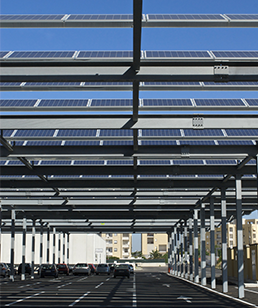
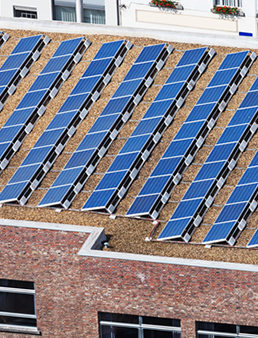
Business-owners can choose between three main options for flat rooftop systems: attached, ballasted or a hybrid of the two. The choice between systems will depend on the roof, the building construction method, and structural engineering analysis. An attached system relies on penetrations in the surface of the roof and connections to the framing. A ballasted system relies instead on the weight of the system, including the panels, racking and other materials, to hold the array down. A hybrid is considered a minimally attached system and it requires a combination of penetrations and ballasting.
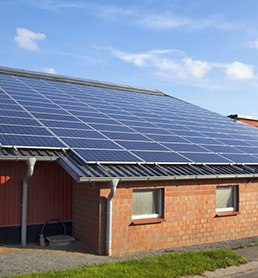
Solar systems have advanced to accommodate all types of roofs including slanted ones. Commercial solar suppliers and installers can work with business owners to take advantage of solar power and its many benefits even if the roof is sloped and composed of metal, composition shingle, wood shingle, or even Spanish tile. Slanted rooftops are not eligible for ballasted mounting systems and require penetrations to remain attached to the roof.
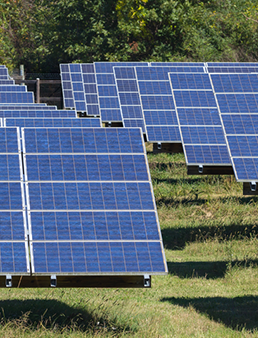
Ground-mounted systems are a cost-effective option for businesses with rooftops that are not suitable for solar or that are too small to meet electricity needs. If the business owner has the land available, ground-mounted systems can be sized to match electricity consumption and designed to be as effective and productive as possible. There are two main types of ground mounts. Standard ground mounts have metal framing driven into the ground to keep solar panels at a fixed angle. Pole mounts elevate panels higher off the ground and sometimes use tracking systems to tilt toward the sun.
Trackers are designed to increase energy production as motors move the panels to follow the sun. Single-axis systems move the panels east to west, dual-axis systems track along both the x and y axes. Tracking systems ideally allow consumers to get more kilowatt-hours per panel. However, they require higher development costs and are more expensive to install and maintain compared to the typical solar system that is mounted at a fixed angle and has no moving parts. Trackers are not as popular as the traditional fixed-mounted systems, and their reliability is often questionable, but advances in technology may make them more affordable and dependable in the near future.
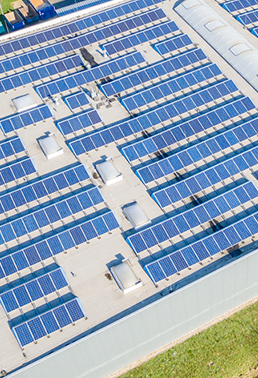
Business owners looking to make a bold statement should consider artistic systems. Solar panels can now be arranged into creative, beautiful arrays that convey a message without sacrificing energy production. One North Carolina-based business, CEI, installed a solar array on their rooftop with the panels arranged to spell out the company name. CEI can now be seen on satellite images from space. Disney’s solar farm in Florida boasts strong brand messaging thanks to its fun and iconic Mickey Mouse shape. While these are examples of large arrays, smaller systems can also be designed for on-point branding. As expected, however, the more customized and unique a system is, so too will the cost for design or installation likely rise.
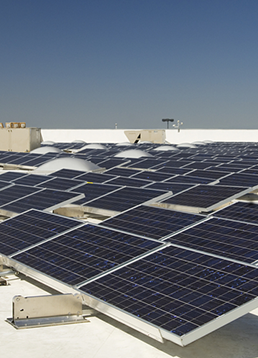
Utility-scale solar generates clean energy that is sold to utility buyers, not individual consumers. Federal and state policies encourage the development of these clean energy projects. According to the Solar Energy Industries Association, in the U.S. there are currently 37,000 MW of utility-scale solar projects, with another 74,000 MW under development. There are many benefits to utility-scale solar, including its environmental and economic benefits. Solar on such a large scale is one of the fastest ways to reduce carbon emissions. In addition, these solar plants generate fixed-price electricity, while fossil fuels fluctuate constantly in price.
3 Factors That Can Stymie Your Solar Plan
Even if you have a large, sunny, flat roof that seems perfect for solar, there are a few standard things to look out for:
While some states have encouraged and incentivized the use of solar energy, others have not. To find out about polices in your state, check out our state pages.
Utility companies have standard interconnection standards that help protect the consumer’s system and the utility system. Depending on the location, there are different standards that need to be met before a system can connect to the grid. Certain restrictions may prevent a business owner from installing a grid-tied solar energy system.
Roofs built before the 1970s or those that require repairs or replacement might not be good candidates for solar. Shadzi also notes that when the rafters are of questionable thickness, she will hire a structural engineer to evaluate the roof’s limitations.
Step-By-Step Guide to Commercial Solar
Plan a Site Audit
During the audit, the solar company will review utility consumption and cost by reviewing your utility bills. They will complete a walk-through of the building or grounds. Information about the facility is gathered, including measurements of beams and structural walls, to aid in the system design process. The installer then submits a proposal with the recommended location, orientation, and slope of the system, as well as its size and energy production. It will also detail the specific models of solar panels and inverters and a description of the wiring. The proposal will state the cost of the system including the equipment and labor, minus rebates, and other incentives, projected energy costs and savings, and warranty information.
Review the Engineer’s Plan
Information collected during the audit is delivered to solar engineers who then plan, design, and sometimes implement the solar energy project. During this process, the engineer may report on the cost, efficiency, and safety of the project. Depending on the solar company, the engineer may be part of the site audit.
Complete Permitting
Once the plans for the system are complete, all permitting requirements must be completed. Unfortunately, there is no standardized permitting process. Depending on the state, local government, and size and complexity of the system, this process can move along quickly or take a lot of time and money. Shadzi’s Cosmic Solar has its own staff member dedicated solely to permitting. At this point, the system owner or their installer will begin completing paperwork for rebates and incentives.
Watch Your Panels Get Installed
Each project varies and can take between two days to two weeks or longer depending on the size of the system. For the typical attached or hybrid system, holes are drilled into the rafters in alignment with the solar panel mounts. Thin pieces of metal are then placed over the mounts, preventing water leakage. The panels are attached to the rails and connected together. Finally, the solar panels are connected to the inverter.
Schedule Final Inspection
Before it can be used, the utility or city building department will complete a final inspection. Inspectors ensure that the modifications to the building or grounds are up to code and that proper permitting was acquired.
Submit Utility Interconnection Request
System owners submit an interconnection request to their utility. Depending on where you live, the interconnection waiting time, requirements, fees, and application forms will vary. Each state has jurisdiction over interconnection to the grid and in many parts of the country, this process can be very complex and cost-prohibitive.
Activate Monitoring Plan
With no moving parts, the typical grid-tied solar system is very low maintenance. Make sure the system remains free of dust and debris, and clean with gentle soap and a mop or squeegee to remove stubborn bird droppings or dust. Monitoring devices and services are also available to give a system owner valuable information about a system’s performance, including how much money and CO2 has been saved.
Residential vs. Commercial Solar Systems
Commercial arrays are often larger in size compared to residential arrays. With more rooftop space available and higher electricity needs, commercial projects need larger panels that are designed with more cells. Since commercial rooftops are generally flat, they are typically installed using a ballasted, non-penetrating mounting system. This makes installation easier. However, the increased number of panels for the array compared to a residential array adds to the project time.
A commercial solar panel is generally composed of 92 cells, making it 12 inches wider than a residential panel with an average of 72 cells. This is made possible as commercial rooftops are larger than residential roofs. The higher the cell count, the more electricity is produced. This is necessary as businesses have higher electricity needs, serving more people and powering more equipment than a typical home. Residential projects are also designed to be low-profile and attractive, most often using black, slim panels. Commercial projects, on the other hand, are white, bulky and noticeable. However, since most commercial rooftops are not visible, this is not an issue. See our Ultimate Guide to Solar Panels for more details.
Commercial panels are more efficient at producing electricity since they are larger than residential ones. They boast an efficiency rating of 20 percent, about 2 percent more efficient than their residential counterparts. In 2016, Panasonic’s launched what it called the most powerful photovoltaic panel in the world. The panel boasts 23.8 percent efficiency.
Energy consumption for businesses is usually highest during the day, a peak time for utility rates. It is also when solar panels are producing the most amount of energy. Compared to residential projects which use electricity during the evening and into the night, commercial arrays can offset more from their utility charges.
Solar expert Shadzi notes that commercial systems need to be designed carefully because the electric utilities charge companies “demand” charges based on collective energy consumption at any given time. While the price of energy might be lower during the day, demand charges can decrease these savings.
Financing Commercial Solar Panels

Business owners can purchase their solar system outright. To start reaping the benefits of lower electricity costs without having to cover the cost of a loan, this type of financing is ideal. However, this option requires a significant amount of upfront costs.
The business owner owns the array and is responsible for its maintenance. The owner also takes advantage of all the solar tax and rebate incentives. Shadzi notes that many companies use the equity in their business or building to obtain a bank loan.
By leasing or signing a Power Purchase Agreement (PPA), business owners are renting the solar system from a third-party owner. The lessor can reap the immediate cost savings with little to no upfront costs. The owner of the system takes any solar tax credits or other financial incentives. Only about 24 states and Washington, D.C. allow solar PPAs.
Property-assessed clean energy (PACE) helps home and business owners finance the installation of a solar energy system. Through PACE, a business owner receives financing from a local government to pay the upfront cost for the system. The owner repays the cost through an assessment on their property tax. Financing is secured with a lien on the property.
Almost 30 states and Washington, D.C., have renewable portfolio standards (RPS) that mandate utilities to produce, or purchase, a certain amount of renewable electricity. To meet these standards utilities can obtain Solar Renewable Energy Credits (SRECs) by buying renewable energy from people with solar arrays.
Big Companies Embrace Solar Panels
Walmart, IKEA, Costco, FedEx, Apple, Verizon, and many other large companies across the U.S. and the world are embracing solar in a big way. Cutting costs and helping their bottom line is the driving factor for this shift to clean energy. Solar is also seen as an environmentally responsible and progressive choice. Solar is good for the environment, good for business, and good for a company’s public image.
According to a 2018 Solar Means Business report from the Solar Energy Industries Association, the growth seen in the commercial sector mirrors the overall increase in solar options.
Currently, there are 7,000 MW of commercial solar installations generating 10.7 million MWh of electricity annually.
The report notes that in the commercial sector, solar has increased 183 percent among America’s top companies. Better financing options, a variety of incentives, and the decreasing price of commercial systems, – the cost to install an on-site commercial solar PV system has fallen by 63 percent over the last decade – have helped spur this growth.
SEIA also notes that companies that have already installed solar energy are adding even more. Each year, these systems offset 7.5 million metric tons of CO2, equal to taking 1.6 million cars off the road each year. As an effective and environmentally conscious method of cutting costs, many large companies are advocating for more solar-friendly policies. In 2014, a dozen high-profile companies wrote and signed the Corporate Renewable Energy Pledge. The Pledge asked utility companies to make it easier for them to purchase energy from clean, renewable energy. Shortly thereafter another group of companies started the RE100 company, a collaborative, global initiative of influential businesses committed to 100 percent renewable electricity, working to massively increase demand for – and delivery of – renewable energy. In 2019, there are 219 RE100 companies.
The top five companies by solar capacity in 2018 were Apple, Amazon, Target, Walmart, and Switch. These distribution centers, tech giants, and warehouse behemoths know the value of solar for their company. Solar energy clearly has good friends in high places that will continue to advocate for and use solar energy.
Commercial Solar FAQ
Shadzi notes that anything using electricity in a business can be powered using solar energy, including electric pumps. With enough space and the right array, the business owner can cover all of its electricity needs.
The size of the solar system depends on the business’ electricity needs, roof size, and investment amount. A professional installer will conduct a client consultation or site audit to help you determine the size of the solar system that best fits your needs and budget.
Less sunlight can be compensated for by adding more panels. However, while weather is not a problem, anything that blocks sunlight such as dust, bird poop, shading from trees or other buildings, or fallen leaves will impact efficiency.
Solar installers are able to work with most any roof to create a cost-saving solar energy system. Southwest facing roofs generate the most annual production. East and north will produce less energy.
Generally, an attached system will add 3 pounds per sq. ft. of weight to the roof, a ballasted system will add 4 to 6 pounds. If the business was built after 1970, it should support these loads. However, if concerns arise, a structural engineer will review the property.
When comparing solar contractor bids, Shadzi suggests looking at the price per watt. However, she warns, consumers need to compare apples to apples. A 300-watt per panel system with 12 panels should cost less than a 340-watt system with the same number of panels.
The panels do not need heat or bright sunshine, they need light. In fact, on a hot day, the system is not as efficient because all of the equipment heats up. Even in states where it snows the panels get warm, melting the snow.
Solar panels require light to produce energy so on cloudy days the solar panels will generate less electricity than on clear, sunny days. During the nighttime, the panels are not producing any energy.
Business owners with a solar system that adheres to all utility standards and connection policies will be able to connect to the utility. Connecting to the grid allows the business owner to transfer surplus power generated from the system to the utility grid.
Solar systems that are grid-tied are connected to the public utility grid. The system generates electricity for a home or business and transfers the surplus power onto the utility grid. Through net metering, the system owner is compensated by from the utility company for the excess power generated.
Currently, there is a federal investment tax credit (ITC) of 30 percent for any qualifying residential or commercial solar system. This tax credit is slated to fall to eight percent at the end of 2021. Depending on where you live there are many other state and local government incentives.
The owner of the building needs to approve the installation of the solar system and be part of the process. It is not uncommon for renters to approach their landlords to request the installation of solar. The renter can help pay the owner for the system. This arrangement can still be less expensive than paying for high utility charges.
Batteries that are available now require a lot of maintenance and can double the cost of a solar system. Currently, the batteries that are on the market are not even enough for a home but the technology is advancing rapidly and battery-backed commercial projects are a thing of the near future.
Business owners can take many steps to save money on their utility bill. Refit your business with energy-efficient lighting. Avoid energy vampires and turn off electronics. Even when in “standby” mode, they will use energy to power features like clock displays. Professionals who conduct energy efficiency audits can help business owners save electricity and generate more savings.




